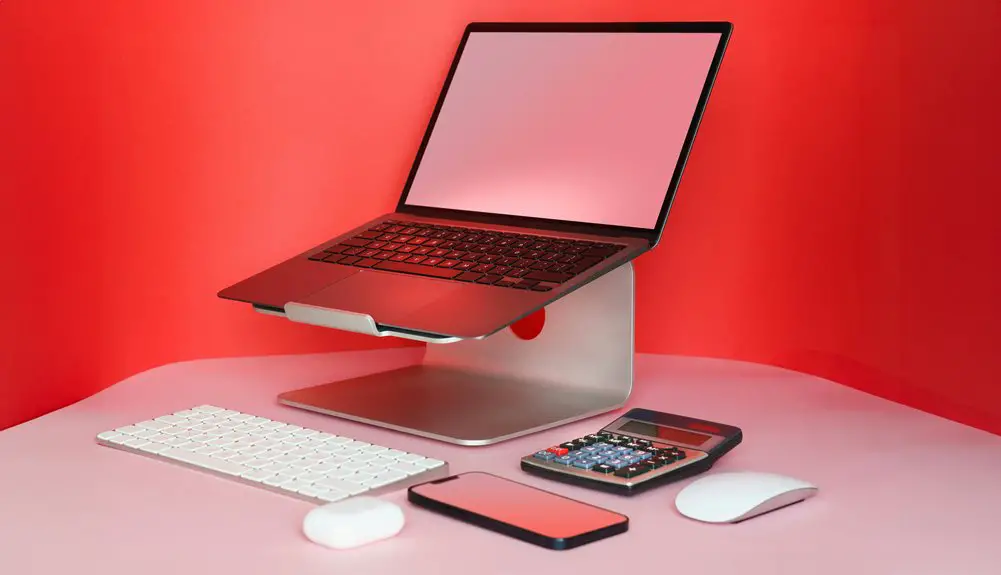Finding the right side button placement on a vertical mouse is key for comfort and productivity. Opt for thumb-activated buttons for better hand positioning or forward placements for quick access, though they might feel awkward. Test various configurations to discover what works best for your grip style. Don't forget to customize button functions to enhance your workflow. If you want to learn more about adjusting to your vertical mouse, tips are just ahead.
Table of Contents
Key Takeaways
- Evaluate thumb-activated buttons for better hand positioning, enhancing comfort and accessibility during use of a vertical mouse.
- Consider forward button placement for quick access, but be aware of potential awkward finger movements.
- Test rearward buttons to reduce thumb strain, though they may feel distant for some users.
- Explore ambidextrous designs for versatility, keeping in mind they may lack optimal comfort for certain hand sizes.
- Personalize button functions to match your workflow, improving efficiency and familiarity during extended use.
Understanding Vertical Mouse Designs
When you explore vertical mouse designs, you'll quickly notice how they differ from traditional mice. The vertical orientation promotes a more natural hand position, reducing strain on your wrist. Instead of twisting your arm, you'll keep it relaxed and in a handshake position, which can lead to increased comfort during long usage sessions.
Many vertical mice also feature contours that fit your hand's shape, allowing for better grip and control. You'll find that the buttons are often repositioned to accommodate this new design, making access easier while maintaining ergonomic benefits.
As you try different models, pay attention to weight and size, as these factors can significantly impact how the mouse feels in your hand.
Common Side Button Configurations
Several common side button configurations exist on vertical mice, each catering to different user preferences and tasks.
One popular setup includes a back button and a forward button, perfect for web browsing. You'll find this arrangement intuitive, allowing quick navigation through pages.
Another configuration features customizable buttons, letting you assign specific functions like copy, paste, or even shortcuts for software applications. This flexibility can enhance your workflow significantly.
Some mice also offer a single side button, which can be programmed for a single action, making it a straightforward choice for users who prefer simplicity.
Ultimately, the right configuration for you depends on how you work and what tasks you perform most often. Experimenting with different setups can lead to greater efficiency.
Pros and Cons of Different Button Placements
When choosing the placement of side buttons on your vertical mouse, you need to consider how ergonomics and comfort impact your experience.
Accessibility and reachability can make a big difference in your efficiency, while customization options allow you to tailor functionality to your specific needs.
Let's explore the pros and cons of different button placements to help you find what works best for you.
Ergonomics and Comfort Factors
While choosing a vertical mouse, the placement of side buttons can significantly impact your comfort and overall ergonomic experience.
You want to find a configuration that feels natural, minimizing strain on your hand and wrist. Here are some pros and cons of different button placements:
- Thumb-activated buttons: Easier to reach, promoting better hand positioning.
- Forward placement: Allows for quick access, but may require awkward finger movements.
- Rearward buttons: Less strain on the thumb, but may feel distant for quick tasks.
- Ambidextrous designs: Versatile, but can lack optimal comfort for specific hand shapes.
Evaluate these factors to enhance your user experience and prevent discomfort during extended use.
Accessibility and Reachability
Choosing the right side button placement on a vertical mouse is crucial for ensuring accessibility and reachability during use. You want buttons that are intuitive to reach without straining your hand. Let's look at some pros and cons of different placements:
| Placement | Pros | Cons |
|---|---|---|
| Thumb Position | Easy access with thumb | May feel cramped for larger hands |
| Side of Index Finger | Natural finger movement | Can be hard to reach quickly |
| Behind the Wheel | Less accidental clicks | Requires hand repositioning |
| Front of Mouse | Quick access for frequent tasks | May interfere with grip |
Customization and Functionality Options
Customization options for side button placements on a vertical mouse can significantly enhance your user experience. By adjusting the button locations, you can tailor functionality to suit your workflow.
Here are some pros and cons of different button placements:
- Pros:
- Increased efficiency with frequently used commands
- Reduced strain on fingers and wrists
- Personalization that matches your unique grip style
- Enhanced productivity through customizable shortcuts
- Cons:
- Learning curve as you adjust to new placements
- Potential for accidental clicks if buttons are too accessible
- Limited options on some vertical mouse models
- Compatibility issues with software that doesn't support customization
Finding the right placement can help optimize your comfort and performance.
How Side Button Placement Affects Workflow
As you navigate your tasks, the placement of side buttons on a vertical mouse can significantly influence your workflow. If the buttons are easily accessible, you can quickly execute commands without disrupting your flow. This efficiency can save you precious seconds during repetitive tasks, allowing you to focus on what truly matters.
Conversely, awkward button placement might lead to frustration, slow down your speed, and increase the risk of hand strain. Think about how often you use those side buttons for shortcuts or navigation. If they're positioned just right, you'll find yourself working more fluidly, boosting your productivity.
Ultimately, the side button placement should feel intuitive, enhancing your experience rather than hindering it.
Choosing the Right Vertical Mouse for Your Needs
When choosing the right vertical mouse, you'll want to consider ergonomic design to ensure comfort during long hours of use.
Think about your button configuration preferences and how they can enhance your workflow.
Finally, make sure the mouse fits your grip style for optimal control and efficiency.
Ergonomic Design Considerations
Choosing the right vertical mouse involves more than just aesthetics; it's about finding a design that truly fits your hand and work style. An ergonomic vertical mouse can significantly reduce strain and enhance comfort.
Here are some key design considerations to keep in mind:
- Size: Ensure the mouse fits your hand comfortably; larger hands may need a bigger model.
- Grip Style: Consider whether you prefer a palm grip, claw grip, or fingertip grip, as this affects comfort.
- Weight: A heavier mouse can provide stability, while a lighter one may allow for quicker movements.
- Material: Look for a mouse made from materials that feel good against your skin and provide enough grip.
Button Configuration Preferences
How do you prioritize button functionality when selecting a vertical mouse? Your preferences can greatly impact your productivity and comfort. Consider the types of tasks you frequently perform. Do you need extra buttons for shortcuts, or do you prefer a minimal setup? Here's a quick comparison to help you decide:
| Button Type | Ideal Usage |
|---|---|
| Standard Click | General navigation |
| Extra Programmable | Software shortcuts |
| Back/Forward | Web browsing |
| DPI Adjustment | Gaming or design work |
| Scroll Wheel | Page navigation and scrolling |
Grip Style Compatibility
Finding the right grip style for your vertical mouse can significantly enhance your comfort and efficiency during daily tasks.
Different grip styles suit different users, so it's essential to identify which one works best for you. Here are four common grip styles to consider:
- Palm Grip: Offers full hand contact, ideal for larger mice.
- Claw Grip: Provides a balance between control and comfort with fingers arched.
- Fingertip Grip: Allows for quick movements, best for smaller mice.
- Hybrid Grip: Combines elements of both palm and claw grips for versatility.
Take time to test various styles and find the one that feels most natural.
The right grip can reduce strain and improve your overall experience with a vertical mouse.
Tips for Adjusting to a New Vertical Mouse
As you transition to a vertical mouse, it's essential to give yourself time to adapt to its unique design and functionality.
Start by adjusting your grip; position your hand comfortably on the mouse and let your fingers rest naturally on the buttons. Practice moving the mouse slowly to get used to its angle and feel.
You might find it helpful to customize the button functions to suit your workflow better. Take frequent breaks to prevent strain as your hand adjusts to this new position.
Gradually incorporate it into your daily tasks, allowing your muscle memory to develop. Lastly, don't hesitate to explore different sensitivity settings to find what feels right for you. Your comfort and efficiency will improve with time.
Frequently Asked Questions
Are There Specific Brands Known for Ergonomic Side Button Placements?
You'll find brands like Logitech, Razer, and Anker often prioritize ergonomic designs with thoughtfully placed side buttons. Testing a few models can help you discover what feels best for your hand and usage style.
Do Side Button Placements Differ for Left-Handed Vertical Mice?
Yes, side button placements do differ for left-handed vertical mice. You'll find that many brands design their mice specifically for left-handed users, ensuring buttons are easily accessible and comfortable for your unique grip.
Can Side Buttons Be Customized on All Vertical Mice?
Not all vertical mice allow you to customize side buttons. Some come with preset functions, while others offer software for personalization. Check your mouse's specifications and software options to see what you can adjust.
What Materials Affect the Feel of Side Buttons?
The materials used for side buttons, like plastic or rubber, greatly affect their feel. You'll notice differences in grip, texture, and durability, which can influence your overall comfort and control during use.
How Does Side Button Placement Influence Gaming Performance?
Side button placement directly impacts your gaming performance. If they're easily reachable, you'll execute commands quickly and efficiently. Poor placement can hinder your reaction time, making it harder to respond during intense gameplay moments.




